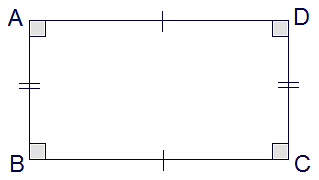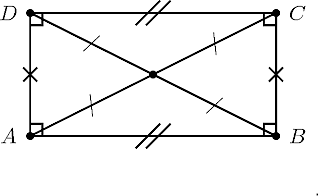
Jasmine Grover Content Strategy Manager
Content Strategy Manager
Area of rectangle is the product of its length and breadth. It is the space enclosed by the rectangle in a 2-dimensional plane or the space occupied within the perimeter of the rectangle. A rectangle is a quadrilateral with 4 sides and 4 vertices. The opposite sides are parallel to each other. All the four angles of a rectangle are equal to 90o. The length and breadth of the rectangle are however unequal. The area of rectangle is measured in square units.
| Table of Content |
Key Takeaways: Types of polygons, Rectangle, Area of Rectangle, Shapes, Geometry, Square, Diagonal
What is the Area of Rectangle?
[Click Here for Sample Questions]
A rectangle is a quadrilateral (polygon with four sides and four corners) with four right angles (of exactly 90 degrees). It can also be defined as a parallelogram with four right angles. Area of rectangle is the region occupied by a rectangle within its four sides. It is a two-dimensional property, thus it contains both length and breadth.
Area of Rectangle Formula
The formula for the area of rectangle is the product of its length and breadth.
Let us take a rectangle with corners A, B, C, and D called ABCD
Area of rectangle = length × breadth

How to Calculate the Area of Rectangle?
[Click Here for Sample Questions]
To calculate the area of rectangle, you have to follow the steps below.
- Note the dimensions of length and breadth of the given rectangle.
- Multiply length and breadth dimensions.
- Write the area of rectangle i.e. the product of its length and breadth in square units.

Also Read: Construction Formula
Example: Calculate the area of rectangle if it is 9m wide and 4m high.
Solution: l = 9m
b = 4m
Area of rectangle will be its length multiplied by its breadth
i.e. area of rectangle = l × b
Area = 9 × 4
Area = 36m²
How to Calculate Area of Rectangle Using its Diagonal?
[Click Here for Sample Questions]
Diagonal of rectangle is the straight line connecting its opposite corners or vertices. There are two diagonals of equal lengths in a rectangle that can be calculated as:
⇒ (Diagonal)2 = (Length)2 + (Breadth)2
⇒ (Length)2 = (Diagonal)2 - (Breadth)2
⇒ \(Length = (\sqrt{(Diagonal)^2 - (Breadth)^2})\)
The formula to calculate the area of rectangle is Length × Breadth.
Alternatively, we can write this product as
\(\sqrt{(Diagonal)^2 - (Length)^2} \times (Length)^2\)
Therefore, Area of Rectangle can also be written as:\(Breadth (\sqrt{(Diagonal)^2 - (Breadth)^2})\)
Why Area of Rectangle is Length into Breadth?
[Click Here for Sample Questions]
The diagonals of a rectangle divide it into 2 equivalent right angled triangles. Therefore, the area of the rectangle is equal to the sum of the area of these two triangles.
Let us try to derive this formula of rectangle.
Suppose, ABCD is a rectangle.

Now, let diagonal AD divide rectangle into two right triangles, i.e. \(\bigtriangleup\)ABD and \(\bigtriangleup\)ACD.
We know that \(\bigtriangleup\)ABD and \(\bigtriangleup\)ACD are congruent triangles.
Area of \(\bigtriangleup\)ABD = ½ x base x height = ½ x AB x BC = ½ x b x l
Area of \(\bigtriangleup\)ACD = ½ x base x height = ½ x CD x AD = ½ x b x l
Area of rectangle ABCD = Area of \(\bigtriangleup\)ABD + Area of \(\bigtriangleup\)ACD
Area(ABCD) = 2(½ x b x l)
Area(ABCD) = l x b
Thus, the area of rectangle = Length x Breadth
Read More:
Things to Remember
[Click Here for Sample Questions]
- Area of rectangle = length x breadth
- A rectangle is a quadrilateral with four right angles of 90 degrees.
- Area of rectangle using a diagonal = \(Breadth (\sqrt{(Diagonal)^2 - (Breadth)^2})\)
- Area of rectangle is the space enclosed by the figure in the 2-D plane.
Sample Questions
Ques. A square and a rectangle have the same perimeter. Calculate area of rectangle if the side of the square is 50 cm and the length of the rectangle is 90 cm. (5 marks)
Ans. Perimeter of square formula = 4 × side of square
Hence, P (square) = 4 × 50 = 200 cm
Perimeter of rectangle formula = 2 × (Length + Breadth)
Hence, P (rectangle) = 2 (90 + Breadth)
= 180 + 2 × Breadth
According to the given question,
180 + 2 × Breadth = 200 cm
2 × Breadth = 200 – 180
Breadth = 20/2
The breadth of rectangle = 10 cm
Now, area of rectangle = Length × Breadth = 90 × 10 = 900 cm2
Ques. The length and breadth of a rectangle are 10 cm and 8 cm individually. Find its perimeter if the length and breadth are doubled and also halved. (5 marks)
Ans. Length of rectangle = 10 cm
Breadth of rectangle = 8 cm
(i) When they are doubled,
l = 10 × 2 = 20 cm
And b = 8 × 2 = 16 cm
Perimeter = 2(l + b) = 2(20 + 16) = 2 × 36 = 72 cm
(ii) When they are halved,
l = 102 = 5 cm
b = 82 = 4 cm
Perimeter = 2(l + b) = 2(5 + 4) = 2 × 9 = 18 cm
Ques. The breadth and length of a rectangle are in the ratio 3:2. If its perimeter is 154 cm, find its length and breadth. (3 marks)
Ans. Let the length of rectangle be 4x cm and that of breadth = 3x cm
Perimeter = 2(l + b) = 2(3x + 2x) = 2 × 5x = 10x cm
10x = 110
x = 11
Length = 3 × 11 = 33 cm
And breadth = 2 × 11 = 22 cm
Ques. Area of a rectangle is 544 cm². If its length is 32 cm, find its breadth. (2 marks)
Ans. Area = 544 cm²
Length = 32 cm
Breadth of rectangle = Area/Length
= 544÷32
= 17 cm
Hence, required breadth = 17 cm
Ques. Find the area of rectangle if its perimeter is 48 cm and its breadth is 6 cm (5 marks)
Ans. P = 2 (l + b)
Here, P = 48 cm; b = 6 cm
Therefore, 48 = 2 (l + 6)
⇒ 48÷2 = l + 6
⇒ 24 = l + 6
⇒ 24 - 6 = l
⇒ 18 = l
Therefore, length = 18 cm
Now, area of rectangle = l × b = 18 × 6 cm2 = 108 cm2
Ques. A floor whose length and breadth are 40 m and 30 m respectively needs to be covered by rectangular tiles. The dimension of each tile is 1m x 2m. Find the total number of tiles that would be required to fully cover the floor. (5 marks)
Ans. Length of floor = 40 m
Breadth of floor = 30 m
Area of floor = length x breadth = 40 m x 30 m = 1200 sq. m
Length of one tile = 2 m
Breadth of one tile = 1 m
Area of one tile = length x breadth = 2 m x 1 m = 2 sq. m
No. of tiles required = area of floor/area of a tile = 1200/2 = 600 tiles
Ques. The height and width of a rectangular wall are 90 m and 60 m respectively. If a painter charges Rs. 4 per m2 for painting the wall, how much would it cost to have the whole wall painted? (3 marks)
Ans. Given, Height = 90 m and Breadth = 60 m
Area of rectangle = w × h
Area of rectangle = 90 × 60
Area of rectangle = 5400 m2
At the cost of Rs. 4 per m2, cost for painting 4800 m2 is 5400 × 4 = Rs. 1,350
Ques. A rectangle is 14 cm wide and 6 cm tall, what is the length of a diagonal? (3 marks)
Ans. Given, length = 14 cm, breadth = 6 cm.
Diagonal = \((\sqrt{(Length)^2 \times (Breadth)^2})\)
= \((\sqrt{196 \times 36})\)
= \((\sqrt{7056})\)
= 84
Ques. The height of a rectangular screen is found to be 40 cm. Its area is found to be 480 cm2. Find the width of the given screen. (3 marks)
Area of rectangle = w × h
Therefore, Breadth = Area/length
Breadth = 480/40
Breadth = 12 cm
Also Read:







Comments